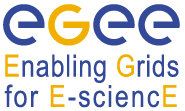Speaker
Describe the added value of the grid for your activity, or the value your tool or service adds for other grid users. This should include the scale of the activity and of the potential user community, and the relevance for other scientific or business applications.
A critical goal of a big Grid infrastructure is to attract users, both to maximize its impact and also ensure its sustainability. However, there is also the requirement that access to grid resources is controlled, secure, and resistant to malicious interventions. This is achieved by the employment of x509 certificates provided by IGTF accredited CAs and authorization systems such as VOMS. While these technologies are very efficient, they require a very steep initial learning curve that can discourage users. An appropriate application that hides innate technical complexities and enables user access as soon as possible, greatly facilitates new user enrollment.
Report on the impact of the activity, tool or service. This should include a description of how grid technology enabled or enhanced the result, or how you have enabled or enhanced the infrastructure for other users.
We have developed a web portal, https://access.hellasgrid.gr, that provides "one stop" user access to Grid. In this web site, users are able to obtain and manage their digital identity, request access to available Virtual Organizations and also request access to their closest User Interface. Support staff is also able to use the interface in order to process user requests and provide them with assistance, should it be needed. Τhe site follows a "step-by-step" approach: User selects an appropriate action, either being digital identity creation or management, fills a form with the data required by each step, then proceeds to the next. When his/her request has been processed, the user is notified via e-mail. Registered users are able to manage their digital identities and use them to access both grid resources web resources that support OpenID or Shibboleth. The portal performs all the possible, previously manual, checks on the user requests, reducing thus the overall support effort.
Describe the activity, tool or service using or enhancing the EGEE infrastructure or results. A high-level description is needed here (Neither a detailed specialist report nor a list of references is required).
The GridAUTh team has been handling Identity Management and Authorization for the Grid in Greece and participates in the nourishment and dissemination of related knowhow in South Eastern Europe Grid infrastructures, activities that are critical for a secure, robust Grid infrastructure, but difficult for users, especially new ones. In order to tackle this, we have developed a web portal that makes the initial steps of a user in the grid as easy as every day web browsing.
